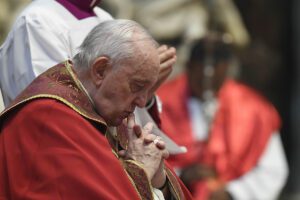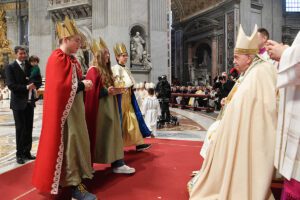VATICAN CITY (CNS) – While bishops may take a cautious approach to the Vatican’s guidance on blessing same-sex or other unmarried couples, they should not deny their priests the possibility of discerning and imparting blessings on people who ask for them, the Vatican doctrinal office said.
“Prudence and attention to the ecclesial context and to the local culture could allow for different methods of application, but not a total or definitive denial of this path that is proposed to priests,” said a press release issued Jan. 4 by the Dicastery for the Doctrine of the Faith.
Each bishop has a responsibility to discern the local application of the declaration “Fiducia Supplicans” (“Supplicating Trust”) on “the pastoral meaning of blessings,” signed by Pope Francis and published by the Dicastery for the Doctrine of Faith Dec. 18, but a bishop should not deny priests the ability to bless people who come to them, the press release said.

Signed by Cardinal Víctor Manuel Fernández, prefect of the dicastery, the statement said it hoped “to help clarify” the reception of “Fiducia Supplicans” among bishops’ conferences.
Besides causing both outrage and celebration on social media, the declaration was greeted by bishops’ conferences with reactions that ran the gamut from embracing its guidance to outright banning local priests from applying it.
Many bishops’ conferences in Western countries, underscoring that the declaration did not change Catholic doctrine on marriage, reacted positively to the document. But others, particularly in Africa, were vocal in their opposition. The Zambian bishops’ conference issued a statement Dec. 20 stating that the Vatican document should “be taken as for further reflection and not for implementation in Zambia.” In Malawi, the bishops’ conference directed that “blessings of any kind for same-sex unions of any kind are not permitted in Malawi.”
Bishop Robert E. Barron, chairman of the U.S. bishops’ Committee on Laity, Marriage, Family Life and Youth, said in a statement Dec. 21 that the document “in no way calls for a change in the Church’s teaching regarding marriage and sexuality.”
Bishop Georg Bätzing, president of the German bishops’ conference, wrote Dec. 18 that he welcomed the document and was “grateful for the pastoral perspective it takes.”
Bishop Oscar Ojea, president of the Argentine bishops’ conference, said Dec. 30 that it would be “inappropriate” to inquire about the moral life of someone asking for a blessing, and he surmised that bishops and ministers who disagree with the Vatican guidance on blessings have not had the experience of witnessing someone simply asking for God’s help or, perhaps, have not even acknowledged a need for God’s mercy in their own lives.
The statements made by bishops’ conferences “cannot be interpreted as doctrinal opposition,” the dicastery’s Jan. 4 statement said, since “Fiducia Supplicans” clearly states the church’s perennial teaching on marriage and sexuality.
“There is no room to distance ourselves doctrinally from this Declaration or to consider it heretical, contrary to the Tradition of the Church or blasphemous,” the statement said.
Still, it acknowledged that while in some places “no difficulties arise” for the immediate application of the declaration, “in others it will be necessary not to introduce them” or to wait until more time is provided for study and for catechesis.
Some bishops have forbidden priests in their diocese from imparting the pastoral blessings laid out in the Vatican document. Archbishop Tomash Peta and Auxiliary Bishop Athanasius Schneider of Astana, Kazakhstan, said in a Dec. 19 statement that they “prohibit priests and the faithful of the Archdiocese of Saint Mary in Astana from accepting or performing any form of blessing whatsoever of couples in an irregular situation and same-sex couples.”
In other local contexts, the Vatican statement said some bishops have given priests encouragement to discern when such blessings may be appropriate, but the dicastery insisted a priest may perform the blessings “only in private.”
The variety of reactions is not “problematic if it is expressed with due respect for a text signed and approved by the Supreme Pontiff himself, while attempting in some way to accommodate the reflection contained in it,” it said.
The statement also discussed at length the situation in countries where homosexuals are threatened with prison, torture or death for being gay. In those places, “it goes without saying that a blessing would be imprudent,” it said. “It is clear the Bishops do not wish to expose homosexual persons to violence.”
But beyond blessings for same-sex couples, the “real novelty” of “Fiducia Supplicans,” the dicastery said, is not the possibility of blessing couples in irregular situations, rather “the invitation to distinguish between two different forms of blessings: ‘liturgical and ritualized’ and ‘spontaneous or pastoral.'”
The statement recognized that while some bishops will choose not to impart pastoral blessings to couples in irregular situations, “we all need to grow equally in the conviction that: non-ritualized blessings are not a consecration of the person nor of the couple who receives them, they are not a justification of all their actions, and they are not an endorsement of the life that they lead.”
“When the Pope asked us to grow in a broader understanding of pastoral blessings, he proposed we think of a way of blessing that does not require the placing of so many conditions to carry out this simple gesture of pastoral closeness, which is a means of promoting openness to God in the midst of the most diverse circumstances,” the statement said.
Concretely, the dicastery said such pastoral blessings last only “a few seconds” and must be performed “without an approved ritual and without a book of blessings.”
If two people approach a priest for a blessing, he “simply asks the Lord for peace, health and other good things for these two people who request it” and that “they may live the Gospel of Christ in full fidelity.”
A simple, brief and non-ritualized blessing “does not intend to justify anything that is not morally acceptable” and is “not an ‘approval’ or ratification of anything either,” the statement said.
The press released also noted that catechesis will be necessary in some places to help people understand that such blessings are “not an endorsement of the life led by those who request them” or a form of absolution, but “simple expressions of pastoral closeness.”







